Cape Breton was the second stop of our road trip through the Maritimes and what a wonderful surprise that was! Our main reason for coming to Cape Breton was to drive the world-famous Cabot Trail; a scenic highway that measures 297 kilometres and forms a loop around the northern tip of the island. Technically, you can drive the full Cabot Trail in one day, however, we gave ourselves a bit more time in order to explore the national park, do some hiking, and visit some of the seaside towns. The drive was every bit as beautiful as we’d imagined, so today, I’m going to share 10 reasons why you should drive the Cabot Trail if you ever find yourself planning a trip to Cape Breton, Nova Scotia!
Cabot Trail Travel Guide for the Ultimate Road Trip on Cape Breton, Nova Scotia
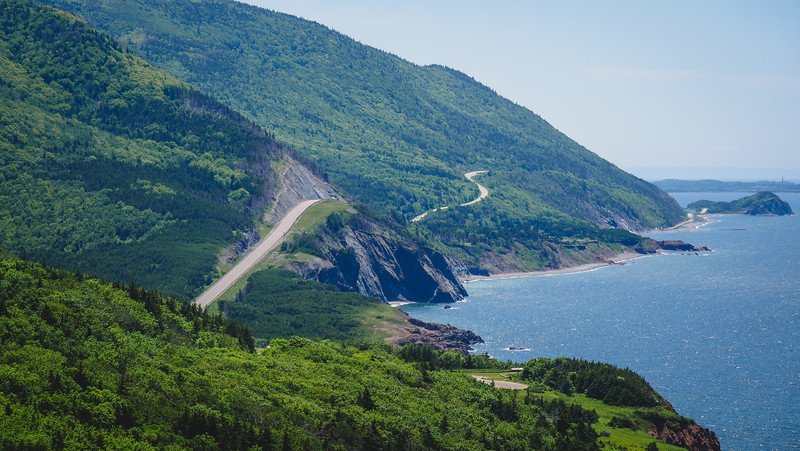
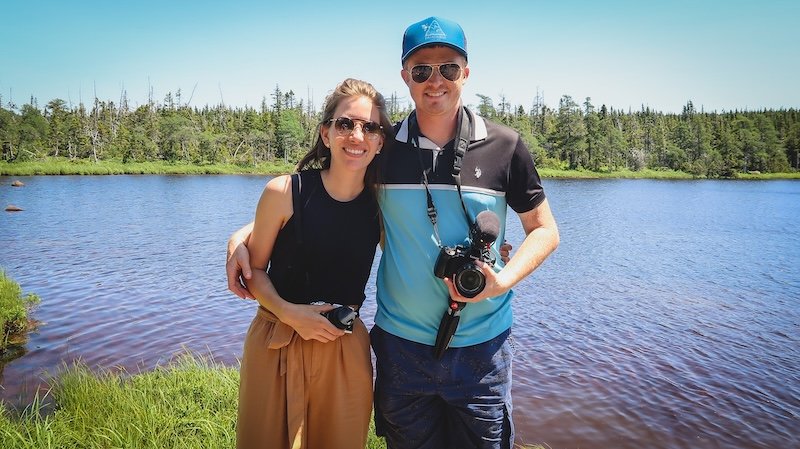
1) It looks like the Scottish Highlands
My first thought when we got on the Cabot Trail was, “This looks like Scotland!”
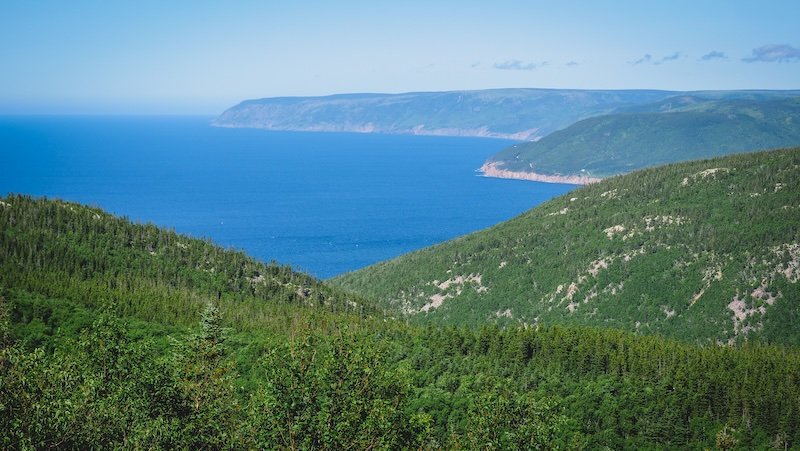
The Cabot Trail encircles the Cape Breton Highlands, and when you stare off at the mountains, it almost feels like you’ve been transported to the Scottish Highlands. The only difference is that the Scottish Highlands have more hardy grasses, while their Canadian counterpart has more scrub forest.
A little taste of Scotland right here in Canada.

2) You can experience French and Gaelic culture
Another surprise on the Cabot Trail was getting to experience French and Gaelic culture on the same island.
On our first day of driving, we travelled clockwise up the west coast where all the signs were in French and English. We passed through towns like Belle Côte, Cap le Moine, Grand Étang and Chéticamp, and when we stopped in a few of these places to eat and do groceries, we could hear French being spoken all around us.
Then, on our second day on the Cabot Trail, we decided to drive counter-clockwise up the east coast. Here, we were surprised to see all the town signs were written in both English and Gaelic. We even drove past a Gaelic College where students can study the language.
It was fascinating to experience these two distinct cultures on the same island.
3) It’s one of the best drives in the world
Another reason to drive the Cabot Trail is that it has been consistently listed as one of the best drives in the world!
It’s especially scenic once you reach the coastal portions where you have the Atlantic Ocean to one side and forested highlands to the other. The winding roads mean you have to drive a bit slower, which is just perfect for enjoying the scenery.
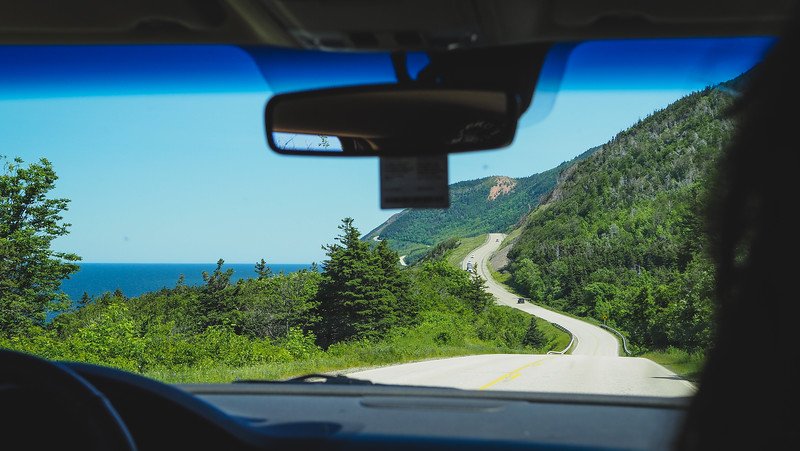
Also, the beauty of driving the Cabot Trail is that despite it being such a well-known route, it’s not too crowded at all! We were expecting to find a lot more traffic, especially as we were driving in the middle of summer, but we never encountered heavy traffic. In fact, there were stretches where we had the whole Cabot Trail to ourselves, which made it a very pleasant drive.
4) Hiking in Cape Breton Highlands National Park
Though the reason for our visit to Cape Breton was to drive the Cabot Trail, we also made sure to get out of the car and experience the natural beauty this destination has to offer. In fact, two of our days were spent hiking through Cape Breton Highlands National Park. This national park was established in 1936, making it the first national park in the Atlantic provinces.
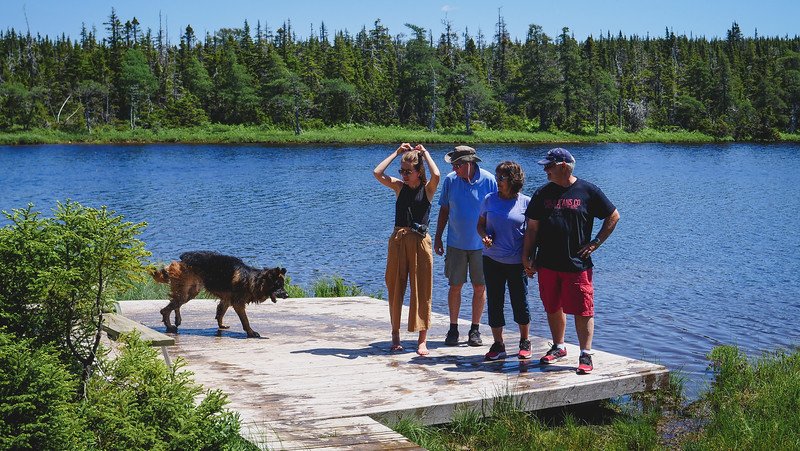
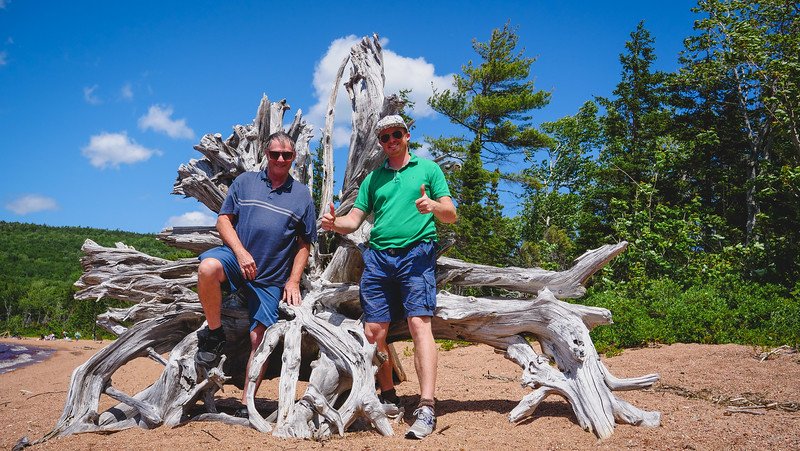
We tackled multiple trails during our visit which took us to hidden coves, rocky beaches, cool lakes and thick forest. Some of the highlights were:
- Le Buttereau – This trail winds through a part of the park where 5 Acadian families lived up until the formation of the park. On this hike, we saw the ruins of their homes and there were information boards that described what life would have been like for this isolated community. One thing that caught my attention was that the women in the community shared chores; each woman was assigned a task like washing clothes, baking bread, churning butter, and they would do so for all 5 families – very efficient in their part!
- Benjie’s Lake – My favourite hike in the park was Benjie’s Lake, where first a dirt trail and later a boardwalk leads you through Boreal forest. This is said to be a good place to spot moose and we didn’t have to walk more than 100 metres before we started seeing moose tracks right in the middle of the trail!
- Warren Lake – This was another nice stop on our drive through the park. The waters at Warren Lake are brownish-red in colour and there’s a nice pink sand beach. It was a bit too chilly for a swim, but the dog loved splashing around.
- Jack Pine – We tackled part of this trail and really enjoyed the scenic lookouts along the Atlantic coastline. There were a few short climbs, but nothing too strenuous.
You may have noticed that we didn’t include the Skyline Trail, the most-visited and best-known trail in the Cape Breton Highlands. That’s because dogs are not allowed on that trail, but also, both times we drove past, the parking lot was packed! Most visitors to the Cape Breton Highlands have this trail on their itinerary, so if you’re planning to visit, it’s a good idea to get there early.
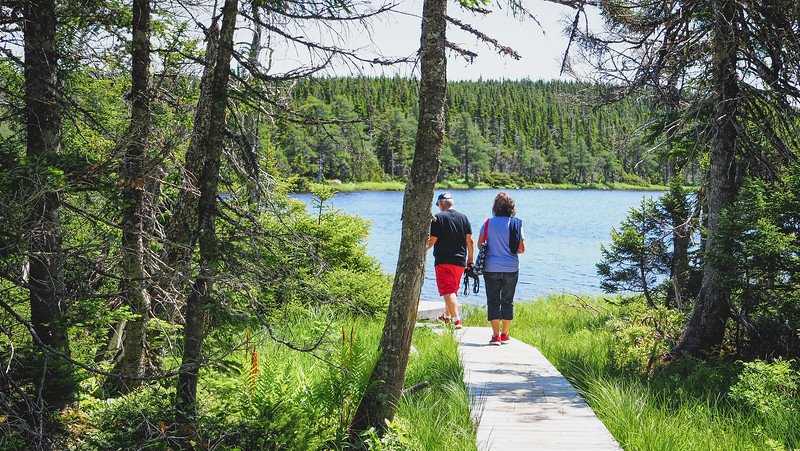

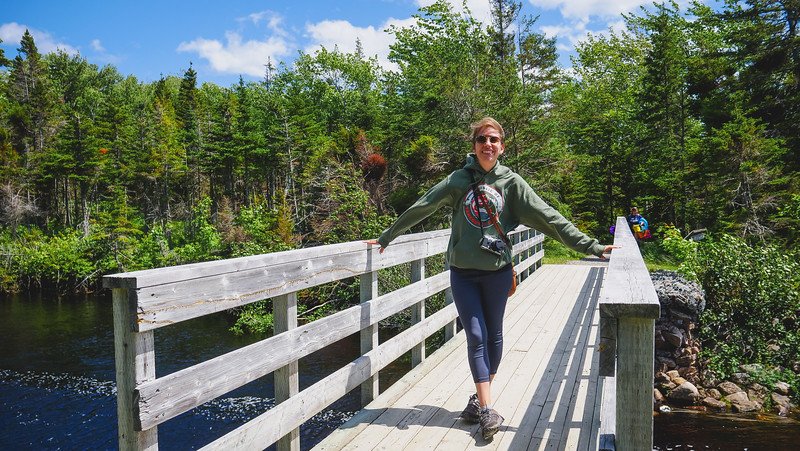
5) You can feast on delicious seafood
What are you in the mood for? Fresh lobster with melted butter, fish and chips, a hearty seafood chowder? Though we made sure to enjoy plenty of seafood, we admittedly self-catered and cooked most of our meals at the barn (more on that later), however, here’s a list of some of the best restaurants in Cape Breton to make all you foodies hungry.
6) You have stunning, red coastlines
I knew Prince Edward Island was known for its red coastlines, but I wasn’t expecting that in Cape Breton. There were stretches of the drive where the coastline ranged from orange to red, and there was even one section where we saw pink rocks!
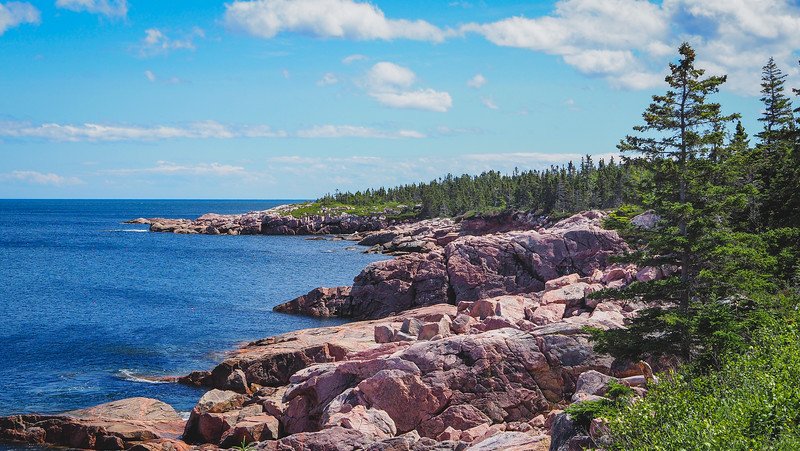
7) You can learn about Alexander Graham Bell
During our Cabot Trail road trip, we made sure to stop in Baddeck to learn about one of Canada’s great inventors: Alexander Graham Bell. I mean, technically he was born in Scotland but we’ve claimed him as one of our own since he spent a good chunk of his life in Canada.
Bell never forgot about his native Scotland and he eventually moved from Ontario to Cape Breton because the landscape reminded him of the Scottish Highlands.
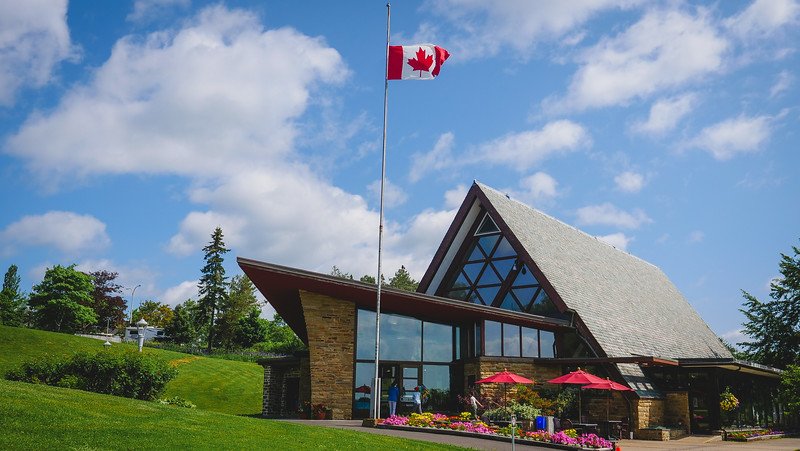
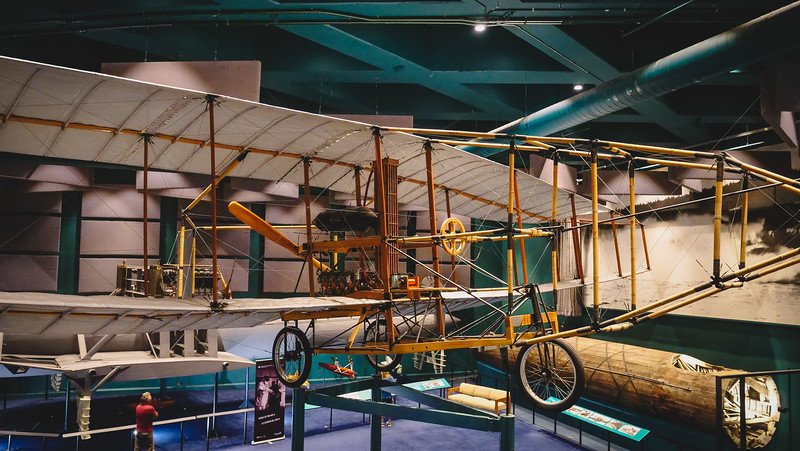
Alexander Graham Bell is best known as the inventor of the telephone, however, the Alexander Graham Bell National Historic Site covers his many achievements beyond that. Bell’s interests were greatly varied and he is also credited with inventing the photophone, the metal detector, the hydrofoil, and designing the Silver Dart which conducted the first powered flight in Canada.
Yet even more interesting than all these inventions is the fact that Bell dedicated most of his life to teaching the deaf, following in the footsteps of his father and grandfather. One of his students was none other than Helen Keller.
8) You can see moose!
One of our bucket list items on this road trip was to see moose. My dad, who has lived in Canada for over 50 years, had never seen one, so he was especially excited about the prospect.
Well, he got lucky and spotted one for himself! It may not have been out roaming in the open, but we managed to catch a glimpse of one behind some trees while it was munching on plants – we could see his silhouette and antlers!
Some recommendations from locals and fellow tourists who’d had luck spotting moose include French Lake, Pleasant Bay, and driving along the backroads of Plateau and Chéticamp around sunset.
If you do decide to go looking for moose, keep in mind that these are wild and unpredictable animals. Keep your distance, stay in the car, and respect their habitat.
9) There are cute seaside towns bursting with colour
Looking back through my photos, I can’t believe I didn’t snap any photos in the towns, but if there’s one thing I’ll remember them for, it’s their bright colours. The homes were painted every colour under the rainbow and they had beautiful verandahs and gardens.
Many of the homes in Cape Breton also had a star affixed to the exterior of the home. These show that the families are of Acadian heritage and it’s something that’s displayed with great pride. Some of the homes in the area were even painted the colours of the Acadian flag, which is the same as the French flag but with an added yellow star on the blue band.
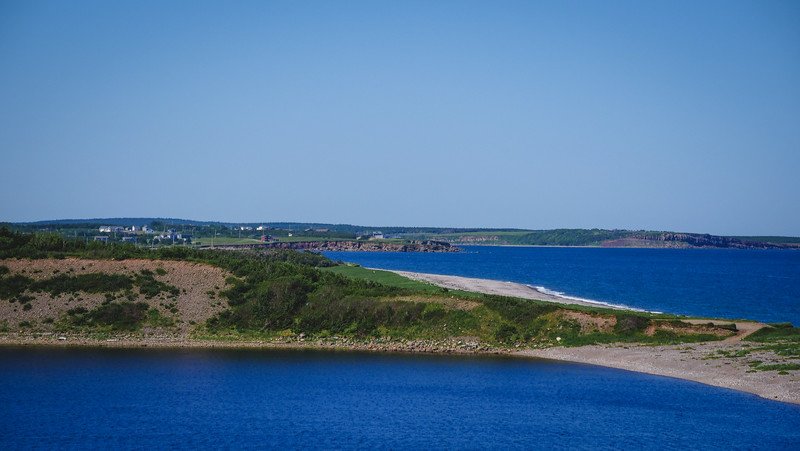
10) You can stay in a barn
There are lots of cool accommodation options along the Cabot Trail ranging from geo-domes and cottages to glamping sites and cape style homes; we opted for a converted barn!
We found this blue barn on AirBnB and it was the perfect fit for us. It was a two-story rustic barn with 4 bedrooms, a large communal dining and living area ideal for large family gatherings, and massive wooden beams that ran the length of the barn and gave it a cosy feel.
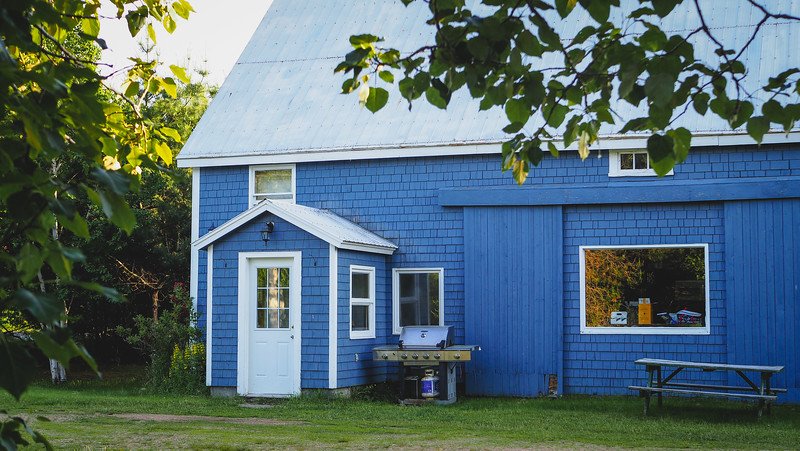
Our place was in Margaree Valley, however, if you want to stay close to the park’s entrances, you can choose Chéticamp on the west side, or Ingonish on the east side.
This was one of the few properties in the area that was dog-friendly, so we snapped it up right away!
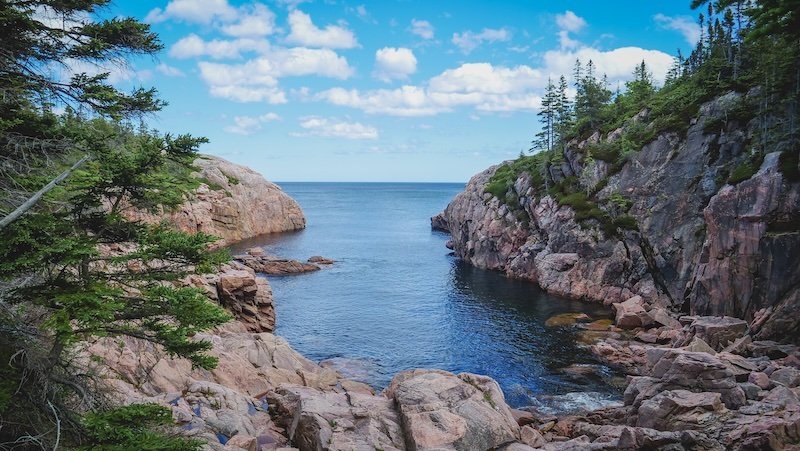
Tips for driving the Cabot Trail
Lastly, a few final tips for driving the Cabot Trail on your visit to Cape Breton, Nova Scotia:
- If you’re flying into Cape Breton, you can use Skyscanner to find the best prices for flights to Sydney.
- For the car rental, you can also pick one up in Sydney, but make sure you book in advance for long holidays and high season. You can compare prices here.
- If you drive counter-clockwise you’ll be on the outer lane overlooking the Atlantic Ocean. If you don’t like steep drops, you can drive clockwise, which will put you in the inner lane.
- Be sure to follow the speed limit posted on the Cabot Trail as there are lots of sharp curves and steep grades. Be especially cautious if you encounter fog or rain.
- If you’re planning to tackle some of the longer and more challenging trails in Cape Breton Highlands National Park, you’ll want a good pair of hiking shoes. I use the Moab hiking boot by Merrell.
- Also, ensure you bring plenty of water, sunscreen and a hat for long days on the trails since not all of them offer shade.
- For additional reading material, you can pick up Touring the Cabot Trail and Beyond, and Lonely Planet’s guide to Nova Scotia, New Brunswick and Prince Edward Island.
- If you’re going to explore beyond Cape Breton, I’d recommend checking out this list of fun things to do in Nova Scotia.
- Lastly, no matter the destination, you should always get travel insurance since you never know what can happen on a trip. You can get a quote based on your destination and length of trip here.
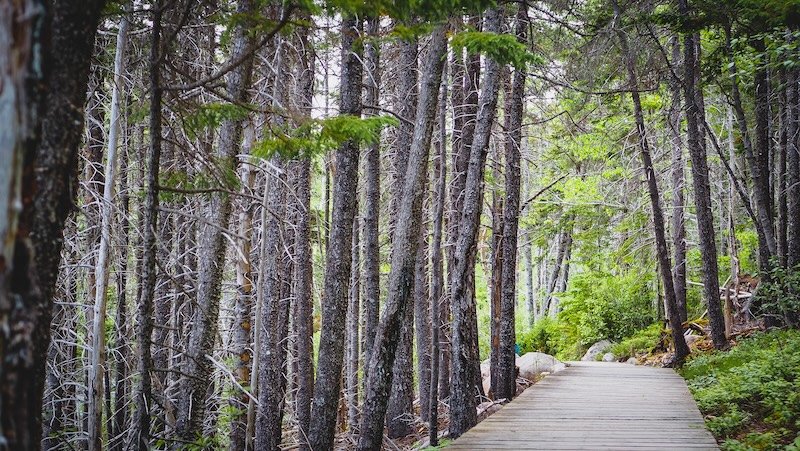
Cabot Trail Trip Planner: Routes, Itineraries, Hikes, Seasons, Stays & Travel Tips
Clockwise or Counter-Clockwise? (It Matters!)
The Cabot Trail is a loop, and both directions are gorgeous—but the experience feels different depending on which way you go.
| Direction | Best For | Why You’ll Love It | Heads-Up |
|---|---|---|---|
| Clockwise (Baddeck → Chéticamp → Pleasant Bay → Ingonish → back to Baddeck) | Drivers who prefer the inside lane on cliff-hugging segments | Feels a touch “cozier” on the steeper coastal stretches; west-to-east means you end many days bathed in golden light over the Gulf of St. Lawrence | Ocean is on the left for long stretches (passenger won’t get the outer-edge views as often) |
| Counter-Clockwise (Baddeck → Ingonish → Pleasant Bay → Chéticamp → back to Baddeck) | Passengers who want the constant ocean panorama | Outer lane delivers those big-sky, big-sea views; sunrise over the Atlantic on the east, sunset over the Gulf on the west | Drivers who dislike drop-offs may feel more exposed on some curves—go slow and enjoy the vistas |
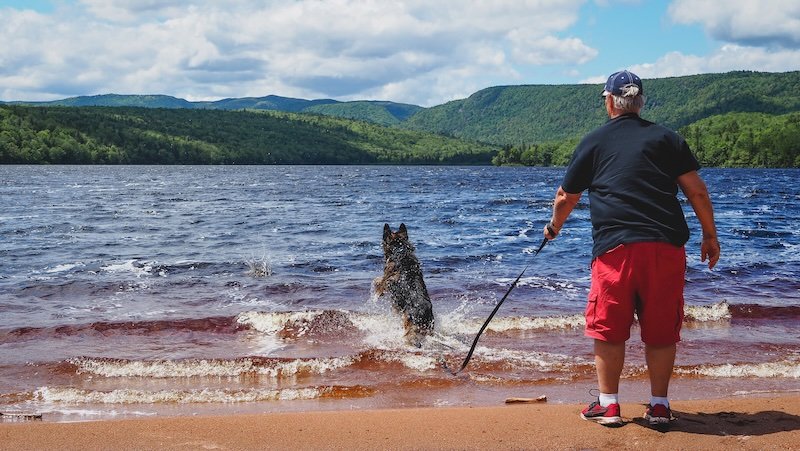
How Many Days Do You Need?
- 1 long day: Doable, but rushed (mostly windshield time).
- 2 days: The sweet spot for a sampler of lookouts + 1–2 short hikes.
- 3–4 days: Chef’s kiss—time for multiple hikes, beach stops, small towns and seafood feasts.
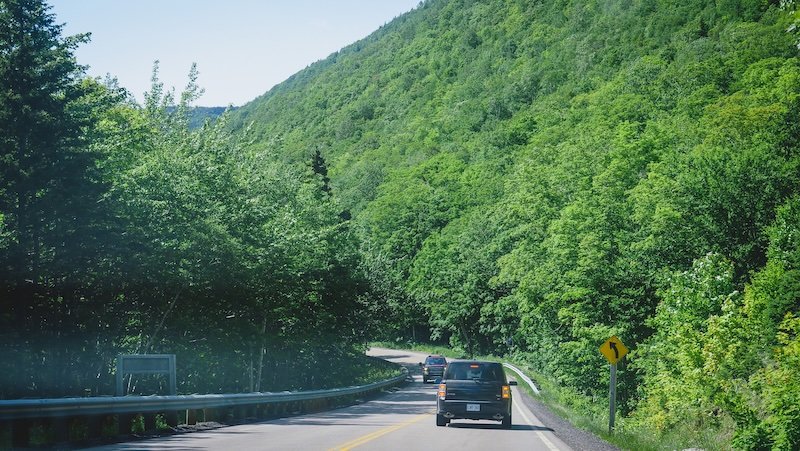
Ready-Made Itineraries (Pick Your Pace)
2-Day Highlights Loop
Day 1 (West Coast focus): Baddeck → Margaree → Chéticamp (Acadian vibes) → coast pullouts and short strolls (Le Buttereau, Jack Pine partial) → sunset viewpoints near Pleasant Bay.
Day 2 (East Coast focus): Ingonish beaches → short hike (think Middle Head if you want that headland drama) → Cape Smokey lookouts → back to Baddeck via lakes.
3-Day Hikes + Culture
Day 1: Baddeck → west coast lookouts → Le Buttereau (historic homesteads), Warren Lake swim (dog-friendly) → overnight Chéticamp.
Day 2: Benjie’s Lake boardwalk stroll → picnic with mountain views → Pleasant Bay for sunset/moose spotting (from the car, at a distance) → overnight Pleasant Bay or Dingwall.
Day 3: Ingonish area: Middle Head trail, beach time, gelato/lobster rolls → Baddeck detour for Alexander Graham Bell site.
4-Day Slow Travel
Add: a longer coastal trail segment, a beach siesta, and unhurried village wanders (colorful houses + Acadian star hunting). If you extend beyond the loop, save a day for Fortress of Louisbourg or a ceilidh (traditional music session) elsewhere on the island.
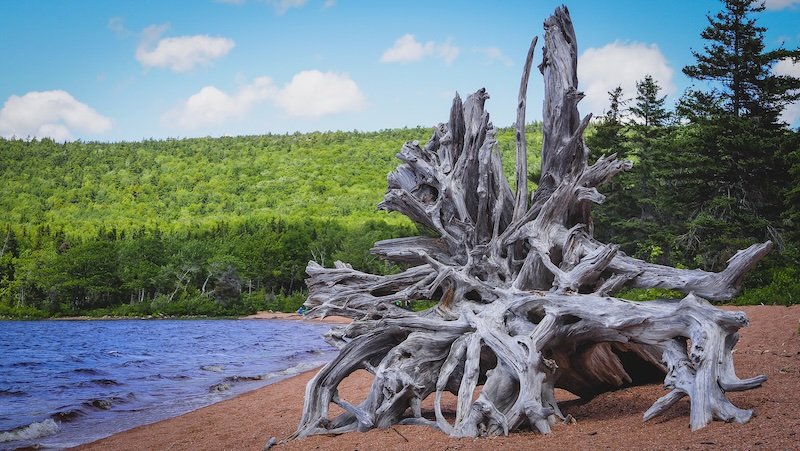
When To Go: Seasons at a Glance
| Season | What It’s Like | Why Go | Things to Note |
|---|---|---|---|
| Late Spring (May–June) | Cool mornings, fresh greens, lighter crowds | Waterfalls and wildflowers, wildlife activity | Layers needed; some businesses open later in May |
| Summer (July–Aug) | Long days, warmest temps, lively villages | Beach time, boat tours, micro-festivals | Book stays and cars early; pack sun + bug protection |
| Early Fall (Sept–mid-Oct) | Crisp air, fiery foliage | Peak scenery, excellent hiking conditions | Cool evenings; prime time = popular lookouts busier |
| Late Fall (late Oct–Nov) | Quiet roads, moody coastal light | Solitude, bargain stays | Short days; some seasonal closures start |
| Winter | Wild beauty, sparsest crowds | For experienced winter drivers only | Check weather/closures; limited services |
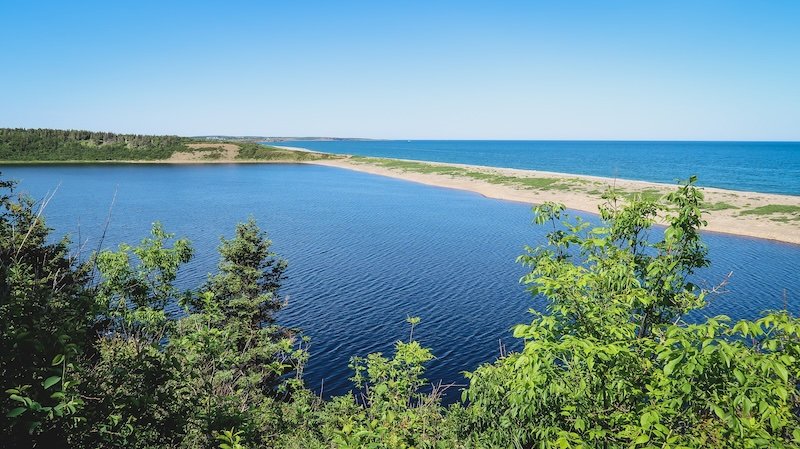
Scenic Pullouts & “Don’t Miss” Viewpoints
West/Acadian Coast (Chéticamp side):
- Cap Rouge area pullouts: sweeping Gulf views and red-tinged coast.
- Cormorant/Corney Brook roadside stops: quick leg stretch + salty air.
- Pleasant Bay area: sunset stunners, occasional roadside wildlife sightings (stay in your vehicle and give space).
Highlands Spine:
- MacKenzie Mountain lookoffs: mountains rolling to the sea; dramatic S-curves.
- Meadow pullouts with picnic tables—perfect for a coffee + pastry break.
East/Atlantic Coast (Ingonish side):
- Cape Smokey lookoffs: classic “road ribboning along the cliffs” shot.
- Lakies Head: rugged rocks and thunderous surf days.
- Neil’s Harbour: postcard harbor with a lighthouse and pastel houses.
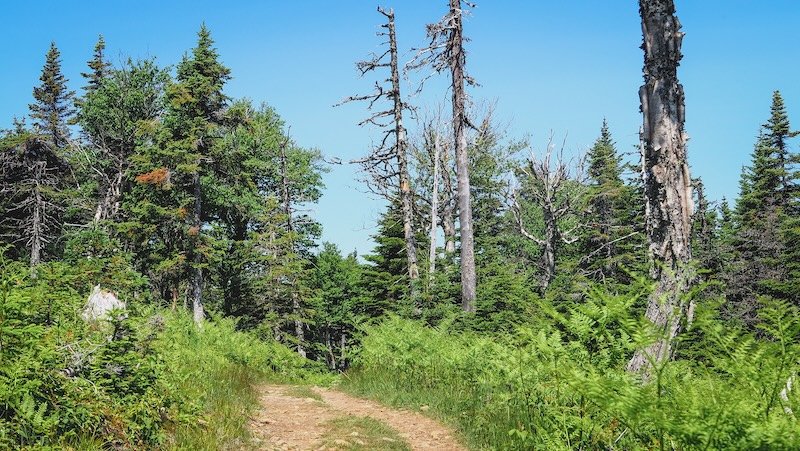
Hikes Cheat Sheet (With Dog-Friendly Notes)
Always check current trail status at park entrances—conditions change with weather/wildlife activity.
| Trail | Distance/Time | Vibe | Effort | Dog-Friendly?* |
|---|---|---|---|---|
| Le Buttereau | ~3–4 km / 1–1.5 hr | Acadian homesteads + meadow views | Easy | Yes (leash) |
| Benjie’s Lake | ~3 km / 1 hr | Boreal forest boardwalk, moose tracks if you’re lucky | Easy | Yes (leash) |
| Warren Lake | Loop ~5 km / 1.5–2 hr | Lakeside forest + beach | Easy-Moderate | Yes (leash) |
| Jack Pine (partial ok) | Up to ~2.5 km / 1 hr | Coastal barrens + viewpoints | Easy | Yes (leash) |
| Middle Head (Ingonish) | ~3.8 km / 1.5–2 hr | Headland trail with cliffs | Moderate (roots/rocks) | Yes (leash) |
| Skyline | ~7–9 km / 2–3 hr | Boardwalk ridge with wow factor | Moderate | No dogs |
Where To Base Yourself (By Coast & Vibe)
| Base | Coast / Location | Vibe | Best For | Why Pick It |
|---|---|---|---|---|
| Chéticamp | West (Acadian) | Colourful, bilingual, seafood-forward | Culture + sunsets | Quick access to west-side trails and Gulf lookouts |
| Pleasant Bay | Mid-loop | Quiet, windswept | “Halfway” convenience | Sunrise one way, sunset the other; less driving backtracking |
| Ingonish | East (Atlantic) | Beaches + coves | Hikers + beach-goers | Close to Middle Head, Cape Smokey, swim spots |
| Margaree Valley | South-west gateway | River life, countryside | Families, unique stays (hello barns!) | Easy striking distance to west coast + lakes |
| Baddeck | Loop gateway | Lakeside town + Bell museum | Pre/post loop nights | Ideal launch/landing pad with services and cafés |
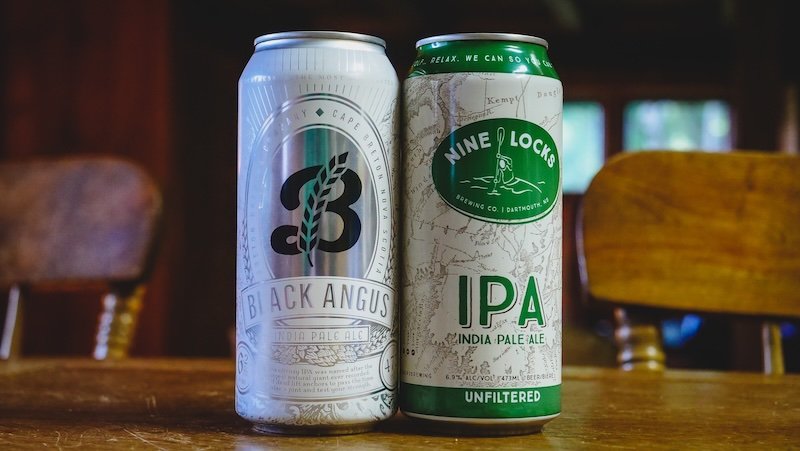
What To Eat and Drink (And When)
- Seafood chowder: the unofficial fuel of the loop—creamy bowls brimming with local catch.
- Lobster roll + butter-dunked lobster: coastal classic; summer menus feature them often.
- Fish & chips: crispy comfort on blustery days (vinegar, please!).
- Acadian specialties: peek at local bakeries/menus for meat pies and sweets.
- Coffee & treats: keep pastries in the car for lookout picnics; small-town bakeries are gems.

Wildlife, Road & Trail Safety
Moose etiquette
- Enjoy from afar—seriously. They’re massive, unpredictable and deserve space.
- Best sightings are typically dawn/dusk—slow down and scan verges with your low beams.
- If you meet one on the road: stay in the car, give way, and wait it out.
Bears & smaller critters
- Keep food sealed; never feed wildlife (for their safety and yours).
- Make occasional noise on trails; store snacks properly at beaches/picnic areas.
Driving the coast
- Expect sharp curves, steep grades, fog and gusty winds.
- Use pullouts to let locals pass and for photos—never stop on blind corners.
- Respect posted speeds; they’re set for the terrain, not to cramp your style.
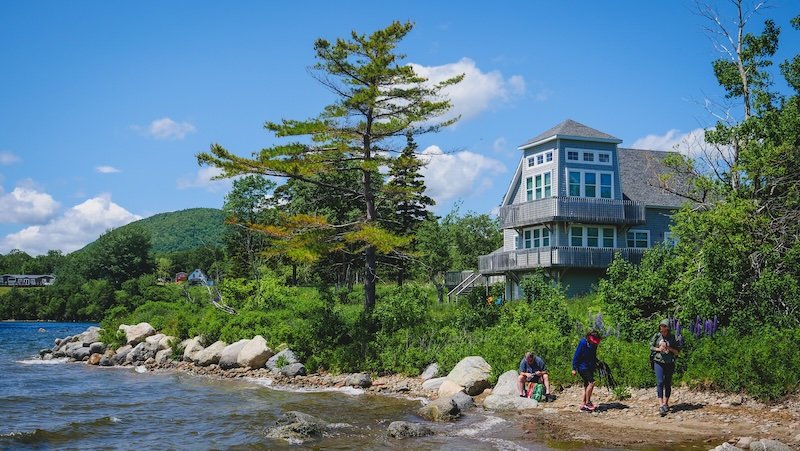
Packing: Road Trip & Day-Hike Essentials
Road Trip Checklist
- ▢ Valid parks pass (if stopping inside Cape Breton Highlands NP)
- ▢ Offline maps (signal can be spotty) + paper map as backup
- ▢ Layers: windproof shell, warm fleece, moisture-wicking base
- ▢ Sun gear: hat, sunscreen, sunglasses
- ▢ Bug spray (summer), lip balm
- ▢ Refillable water bottles + snacks for pullouts
- ▢ Camera/phone + power bank
- ▢ Cash/credit (not everywhere is cashless)
- ▢ Small first-aid kit, motion-sickness tabs if twisty roads get you
Day-Hike Add-Ons
- ▢ Proper footwear (grippy soles; ankle support for roots/rocks)
- ▢ Trekking poles (optional but happy knees on descents)
- ▢ Extra water + high-energy snack
- ▢ Lightweight sit pad/picnic cloth
- ▢ Dog stuff: leash, collapsible bowl, poo bags (pack it out!)
Budget Savers (More Lobster Rolls, Please)
- Mix meals: One sit-down seafood feast + one picnic = happy wallet.
- Free lookouts: Million-dollar views cost exactly zero.
- Midweek stays: Better rates and fewer cars at trailheads.
- Fuel up smart: Top up when you can; don’t roll on fumes between smaller villages.
- Shoulder season: Late spring and early fall offer lower prices without skimping on scenery.
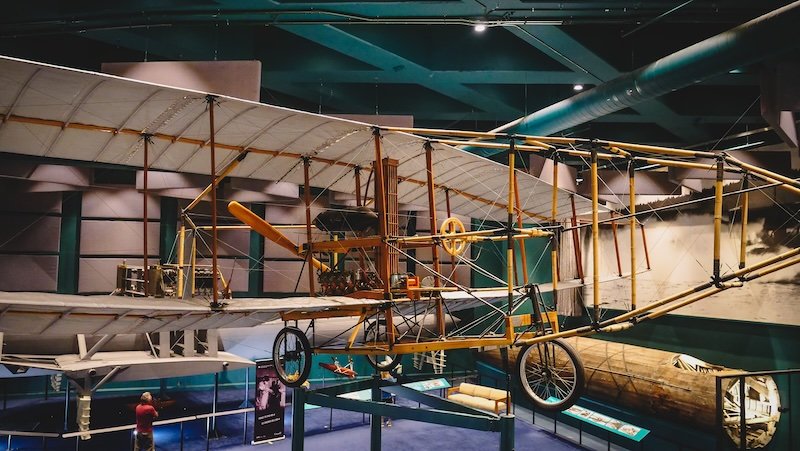
Rainy-Day Plan B (Still Wonderful)
- Alexander Graham Bell National Historic Site (Baddeck): captivating for invention lovers and curious minds alike.
- Local arts & crafts: pottery studios, galleries, weaving—surprisingly plentiful.
- Cafés & bookshops: time slows beautifully in a comfy chair with a warm drink.
- Ceilidh evenings: traditional music sessions pop up around the island—ask locally.
Sample “Perfect Day” (Counter-Clockwise, East to West)
- 8:00 Breakfast + coffee in Ingonish; grab pastries for the road.
- 9:00 Middle Head trail (morning light on the headlands).
- 11:30 Swim/paddle at an Ingonish beach or relax on the sand.
- 13:00 Lunch: lobster roll/fish & chips with a view.
- 14:30 Coastal drive: Cape Smokey lookoffs, Lakies Head rock hop.
- 16:30 Cruise the Highlands spine (stop at mountain lookouts).
- 18:00 Roll into Pleasant Bay/Chéticamp for a chowder dinner.
- Golden hour Finish at a Gulf-side pullout—watch the cliffs blush.
Quick-Compare: Transport & Stays
| Road Trip Style | Pros | Consider |
|---|---|---|
| Car + Inns/Cottages | Comfy, flexible, easy to book | Reserve early in peak; confirm check-in windows |
| Campervan/RV | Everything with you; sunset/sunrise freedom | Book campsites ahead; mind road grades & winds |
| Motorcycle | Twisties + views = dream | Pack layers/rain gear; watch for gusts on exposed cliffs |
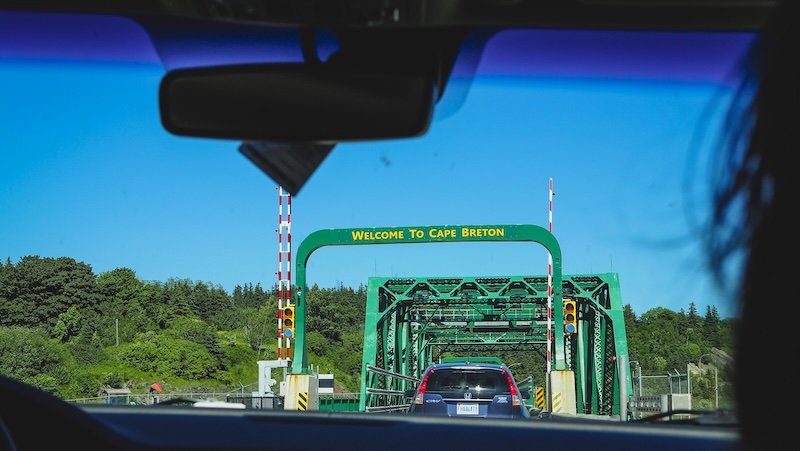
FAQ Cape Breton Trail Road Trip (The Little Things People Always Ask)
Do I need a pass for the National Park?
Yes, if you plan to stop/use facilities/hike within Cape Breton Highlands National Park. You can buy a day pass at entry kiosks or visitor centres.
Is the road scary?
It’s dramatic, not dangerous—if you respect speeds, weather and curves. Use pullouts, take your time, and you’ll be fine.
Can I swim?
Absolutely—lakes and beaches beckon in summer. Water is refreshing (read: brisk on some days), so pack a towel and warm layer.
Will I see moose?
Maybe! They’re wild, which is the magic. Drive cautiously at dawn/dusk, and enjoy any sightings from a distance.
Have you been to Cape Breton?
Did you drive the Cabot Trail?
What did you think?!

Oh i love this! I’m from Nova Scotia and it is so interesting to see all the things I take for granted in a new light. The first time I went to Scotland, I thought it looked soooo much like home 😊
I really appreciate this wonderful post that you have provided for us. The winding roads mean you have to drive a bit slower, yes, i think that is perfect for enjoying your scenery.
If you are interested in history, there are some great sites or musea that are focussed on World War 2
Thanks for the great info. Watched your videos on the East coast and they were very well done your Dad was really entertaining and love your dog as well, the star.
You have inspired us to go!